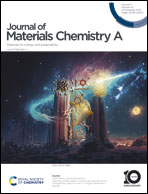Interface molecular wires induce electron transfer from COFs to Pt for enhanced photocatalytic H2 evolution†
Abstract
Covalent organic frameworks (COFs) are excellent platforms for cost-effective photocatalytic hydrogen (H2) evolution research due to their superiority, such as high crystallinity, and highly tuneable photoelectrochemical properties. Yet the efforts in designing high-performance COF-based photocatalysts are largely impeded by inefficient charge separation owing to the interfacial Schottky barrier height (SBH) between COFs and noble metal co-catalysts. To address this challenge, we constructed a robust Pt/sodium citrate (SC)/COF sandwich nanostructure by encapsulating SC-stabilized platinum nanoparticles (PtNPs) into the pores of TpPa-1 COF. The size-matching COF pore with SC-stabilized PtNPs and the hydrogen bonding bridging between SC molecules and COFs jointly ensure the stability of the nanostructure. The obtained composite system with an ultra-low Pt loading of 0.5 wt% shows a visible-light-driven photocatalytic H2 evolution rate of 1.13 mmol h−1 with a high apparent quantum yield (AQY) of 13.5% at 450 nm (the highest value among TpPa-1-based photocatalysts). We attribute the high performance of the composite system to the unidirectional transfer of photogenerated electrons through the SC molecules and the stable sandwich nanostructure. In addition, we have extended this approach to more COF systems and demonstrated excellent universality, paving a new way for efficient photocatalyst system construction.



 Please wait while we load your content...
Please wait while we load your content...